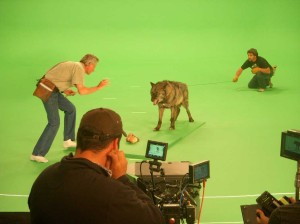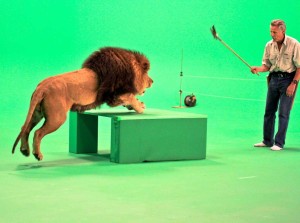 Hollywood Center Studios’ Stage 12 recently hosted a three-day shoot for GreenScreen Animals – a Santa Monica-based supplier of specialty stock footage that was seeking to add to its collection of more than 3,000 stock images of wild animals. The shoot included a pair of gray wolves, two grizzly bears, a leopard, a lion, an African elephant and other exotic animals.
Hollywood Center Studios’ Stage 12 recently hosted a three-day shoot for GreenScreen Animals – a Santa Monica-based supplier of specialty stock footage that was seeking to add to its collection of more than 3,000 stock images of wild animals. The shoot included a pair of gray wolves, two grizzly bears, a leopard, a lion, an African elephant and other exotic animals.
There is a huge demand for stock images of wild creatures, especially hard-to-come-by greenscreen shots that are ideal for special effects. GreenScreen Animals’ animal content has been used in everything from films (We Bought a Zoo) to commercials (FreeCreditReport.com) to late night TV (The Tonight Show with Jay Leno).
Hollywood Center Studio’s Stage 12, a dedicated greenscreen stage with a three-wall, hard cove cyc, provided an ideal location for shooting the animals. Spanning more than 4,000 square feet with a 20-foot high cyc wall, the stage was large enough, for example, to shoot wolves striding 20 to 30 feet.
 “It was a great shooting space,” said GreenScreen Animals co-owner Mark Shockley. “The stage is adjacent to a shaded street where we were able to keep the animals in comfort and safety while they were waiting to go on. For the cats and bears, we could back our trailers right onto the stage. The elephant was able to walk through the stage’s elephant door.”
“It was a great shooting space,” said GreenScreen Animals co-owner Mark Shockley. “The stage is adjacent to a shaded street where we were able to keep the animals in comfort and safety while they were waiting to go on. For the cats and bears, we could back our trailers right onto the stage. The elephant was able to walk through the stage’s elephant door.”
The stage also offered the advantage of being pre-lit. Shockley notes that his crew needed a well-lit stage as they were shooting in 4K and aiming for maximum image quality. “Because the stage was pre-lit, we were able to focus on lighting the animals,” he said. “That saved us a lot of time and allowed us to begin shooting quickly from day one.”
Working with animals on a shooting stage requires great care and meticulous planning. Shockley works with animal trainers who are experts in getting the animals to leap and snarl on cue. Representatives of the American Humane Association were also on hand to guarantee animal welfare.
GreenScreen Animals organizes large scale shoots like this once a year. “We pick spring because the animals’ coats are thick and full from winter,” Shockley explained. “We also do smaller shoots throughout the year with smaller animals. Our next shoot may include foxes, bobcats and skunks.”





